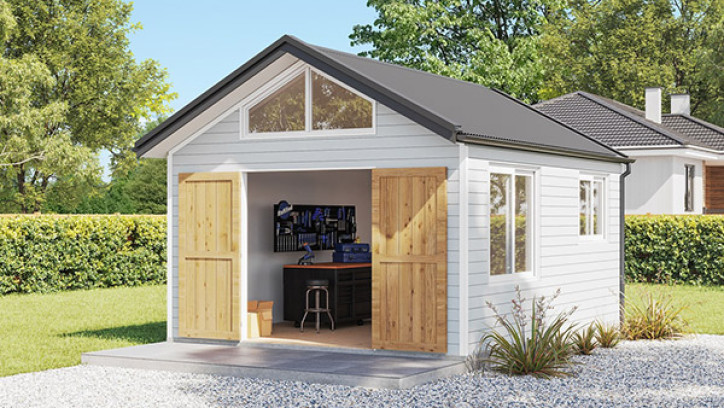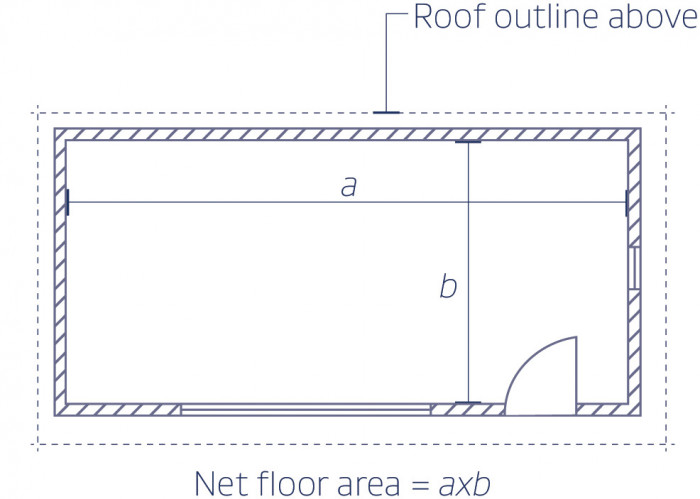2.4. Single-storey detached buildings not exceeding 30 sqm in floor area

This exemption covers the construction of small buildings such as garden sheds, greenhouses, cabins or sleepouts greater than 10 square metres but less than 30 square metres.
This exemption covers the construction of small detached buildings such as garden sheds, greenhouses, cabins or sleepouts greater than 10 square metres but not exceeding 30 square metres.
Before you begin, please read the notes for single-storey detached buildings (particularly District Plan requirements and disposal of stormwater).
Any buildings that include bathroom facilities cannot be built using these exemptions. A building consent is required.
The net floor area of a single storey, detached building is limited to a maximum of 30 square metres. If you are extending an existing single storey detached building, the maximum total net floor area cannot exceed 30 square metres.
The net floor area in a building is measured to the inside of the enclosing walls or posts/columns.

Any design or construction work done using this exemption must be carried out or supervised by a licensed building practitioner (LBP). Homeowners are encouraged to seek LBPs with the right competence for this work, as this provides the best assurance.
The design work is best carried out by an LBP holding a Design license or a Registered architect. The construction work is best carried out by an LBP in one of the following licensing classes, as may be relevant to the building work planned to be undertaken:
- Bricklaying and blocklaying
- Carpentry
- External Plastering
- Foundations
- Roofing
Refer to the Who can undertake exempt work section for more information about Licensed Building Practitioners.
You should also check and confirm the LBPs current licensing status and licensing history before you engage them to carry out work under this exemption.
What is exempt
- The owners of a commercial property intend to construct a 20 square metre detached building to serve as a garage. The proposed building will be more than its own height away from the boundaries and contains no potable water supply, and no facilities for cooking or sanitation. As the owners have contracted a Licensed Building Practitioner to design and construct or supervise the building work, a building consent is not required.
- A 28 square metre sleepout is constructed in the backyard of a residential dwelling. It is more than its own height away from all boundaries and the associated residential dwelling, and does not contain cooking or sanitary facilities, or a potable water supply. The design complies with the technical requirements of the Building Code and was prepared or supervised by a Licensed Building Practitioner. Subsequently, the work is carried out or supervised by a Licensed Building Practitioner in accordance with that design. Fire alarms are specified and installed in accordance with Acceptable Solution F7/AS1 as this building contains sleeping accommodation.
- A rural land owner decides to erect a shed with a net floor area of 30 square metres on a property that does not have a residential dwelling on it. This shed will be more than its own height away from the boundaries and it includes no accommodation, cooking or sanitary facilities or potable water supply. The design and construction will be carried out and supervised by Licensed Building Practitioners.
What needs consent
- A homeowner wishes to erect a sleepout with a net floor area of 33 square metres on a property that has a residential dwelling on it. This sleepout would require a building consent as its floor area is greater than 30 square metres.
- A building owner erects a building to store products in. The building does not contain sleeping accommodation, cooking or sanitary facilities or potable water supply. The building will be 5 metres in height to the apex of the roof, meaning it cannot be built under this exemption as it exceeds the height restrictions of 1 metre to floor level, plus 3.5 metre building height (a maximum height of 4.5 metres).
- A homeowner intends to construct a flat at the back of their property with a net floor area of 29 square metres. This flat will have sleeping accommodation as well as a small kitchen and bathroom. As this building will contain cooking and bathroom facilities, it requires a building consent.
- A rural land owner wants to add a building with concrete block walls to support their farm operation. The net floor area of the building will be 12 square metres. The land owner wants to do it themselves to save money so they are unable to use this exemption as this exemption requires the use of a Licensed Building Practitioner.
What the law says
3B. Single-storey detached buildings exceeding 10, but not exceeding 30, square metres in floor area if work carried out or supervised by licensed building practitioner
1. Building work in connection with any detached building if—
(a). any design or construction work is carried out or supervised by a licensed building practitioner; and
(b). the building—
(i). is not more than 1 storey (being a floor level of up to 1 metre above the supporting ground and a height of up to 3.5 metres above the floor level); and
(ii). exceeds 10 square metres in floor area, but does not exceed 30 square metres; and
(iii). does not contain sanitary facilities or facilities for the storage of potable water; and
(iv). does not include sleeping accommodation, unless the building is used in connection with a dwelling and does not contain any cooking facilities; and
(v). if it includes sleeping accommodation, has smoke alarms installed.
2. However, subclause (1) does not include building work in connection with a building that is closer than the measure of its own height to any residential building or to any legal boundary.